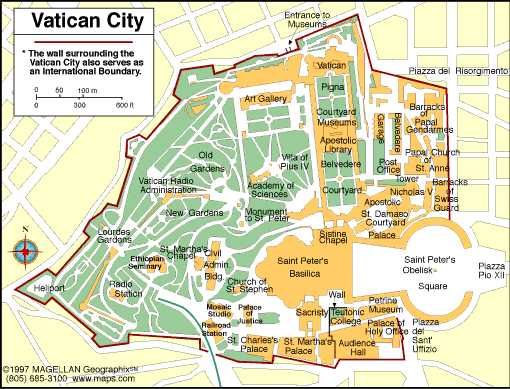VATICAN CITY

Geography: The Vatican City State is situated on the Vatican hill, on the right bank of the Tiber River, within the city of Rome.
Government: The pope has full legal, executive, and judicial powers. Executive power over the area is in the hands of a commission of cardinals appointed by the pope. The College of Cardinals is the pope's chief advisory body, and upon his death the cardinals elect his successor for life.
History: The Vatican City State, sovereign and independent, is the survivor of the papal states that in 1859 comprised an area of some 17,000 sq mi (44,030 sq km). During the struggle for Italian unification, from 1860 to 1870, most of this area became part of Italy. By an Italian law of May 13, 1871, the temporal power of the pope was abrogated, and the territory of the papacy was confined to the Vatican and Lateran palaces and the villa of Castel Gandolfo. The popes consistently refused to recognize this arrangement. The Lateran Treaty of Feb. 11, 1929, between the Vatican and the kingdom of Italy, established the autonomy of the Holy See.
The first session of Ecumenical Council Vatican II was opened by John XXIII on Oct. 11, 1962, to plan and set policies for the modernization of the Roman Catholic Church. Pope Paul VI continued the council, presiding over the last three sessions. Vatican II, as it is called, revolutionized some of the church's practices. Power was decentralized, giving bishops a larger role, the liturgy was vernacularized, and laymen were given a larger part in church affairs.
On Aug. 26, 1978, Cardinal Albino Luciani was chosen by the College of Cardinals to succeed Paul VI, who had died of a heart attack on Aug. 6. The new pope took the name John Paul I. Only 34 days after his election, John Paul I died of a heart attack, ending the shortest reign in 373 years. On Oct. 16, Cardinal Karol Wojtyla, 58, was chosen pope and took the name John Paul II. Pope John Paul II became the first Polish pope and the first non-Italian pope since the 16th century.
Government: The pope has full legal, executive, and judicial powers. Executive power over the area is in the hands of a commission of cardinals appointed by the pope. The College of Cardinals is the pope's chief advisory body, and upon his death the cardinals elect his successor for life.
History: The Vatican City State, sovereign and independent, is the survivor of the papal states that in 1859 comprised an area of some 17,000 sq mi (44,030 sq km). During the struggle for Italian unification, from 1860 to 1870, most of this area became part of Italy. By an Italian law of May 13, 1871, the temporal power of the pope was abrogated, and the territory of the papacy was confined to the Vatican and Lateran palaces and the villa of Castel Gandolfo. The popes consistently refused to recognize this arrangement. The Lateran Treaty of Feb. 11, 1929, between the Vatican and the kingdom of Italy, established the autonomy of the Holy See.
The first session of Ecumenical Council Vatican II was opened by John XXIII on Oct. 11, 1962, to plan and set policies for the modernization of the Roman Catholic Church. Pope Paul VI continued the council, presiding over the last three sessions. Vatican II, as it is called, revolutionized some of the church's practices. Power was decentralized, giving bishops a larger role, the liturgy was vernacularized, and laymen were given a larger part in church affairs.
On Aug. 26, 1978, Cardinal Albino Luciani was chosen by the College of Cardinals to succeed Paul VI, who had died of a heart attack on Aug. 6. The new pope took the name John Paul I. Only 34 days after his election, John Paul I died of a heart attack, ending the shortest reign in 373 years. On Oct. 16, Cardinal Karol Wojtyla, 58, was chosen pope and took the name John Paul II. Pope John Paul II became the first Polish pope and the first non-Italian pope since the 16th century.

Map of Vatican City
Ruler: Francis I (2013)
Land area: 0.17 sq mi (0.44 sq km)
Population (July 2014 est.): 842
Monetary unit: Euro
National name: Stato della Città del Vaticano (Santa Sede)
Languages: Italian, Latin, French, various other languages
Ethnicity/race: Italian, Swiss, other
Religion: Roman Catholic.
Labor force:
2,832 (2011), essentially services with a small amount of industry;
nearly all dignitaries, priests, nuns, guards, and the approximately
3,000 lay workers live outside the Vatican.
Budget (2011): Revenues: $308 million; expenditures: $326.4 million.
Communications: Telephones: main lines in use: 5,120 (2005); mobile cellular: n.a. Broadcast media:
the Vatican Television Center (CTV) transmits live broadcasts of the
Pope's Sunday and Wednesday audiences, as well as the Pope's public
celebrations; CTV also produces documentaries; Vatican Radio is the Holy
See's official broadcasting service broadcasting via shortwave, AM and
FM frequencies, and via satellite and Internet connections (2008). Internet hosts: 107 (2012)
International disputes: none.
-------------------- o --------------------
No comments:
Post a Comment